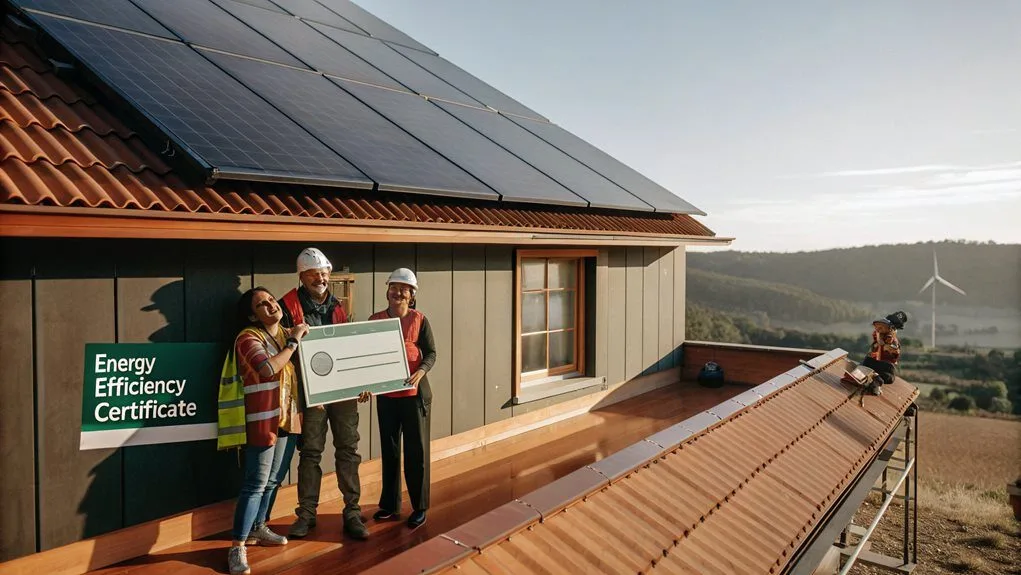Green energy grants provide essential financial support for sustainable home and business improvements across the UK. Government programmes like the Green Homes Grant and Energy Company Obligation Scheme distributed over £687 million in 2021/22, helping reduce carbon emissions nationwide.
Eligibility varies per programme, with requirements ranging from income thresholds to business classifications. The application process typically involves registration, project description, and detailed budget itemisation. The investment delivers measurable returns through reduced operational costs, tax benefits, and improved brand value.
Navigating the Landscape of UK Green Energy Grants
Why have green energy grants become such an important resource for UK residents seeking to improve their homes’ energy efficiency? As energy costs rise and environmental concerns grow, these financial incentives provide vital support for sustainable home improvements that might otherwise remain unaffordable.
The UK’s grant opportunities span multiple funding sources, including government initiatives like the Green Homes Grant and Energy Company Obligation (ECO) Scheme, as well as private foundation contributions. These diverse programmes address various needs across all regions of the UK—England, Scotland, Wales, and Northern Ireland.
Funding diversity ensures green energy access for households throughout all four UK nations
Residents can access grants for:
- Home insulation improvements
- Renewable heating system installations
- Energy-efficient technology upgrades
With over £687 million awarded in 2021/22, these grants greatly contribute to the nation’s carbon reduction goals. The Green Homes Grant scheme alone offered potential savings of up to £600 on energy bills for 600,000 households in England.
Eligibility Requirements: Who Qualifies for Renewable Funding?
While awareness of green grants is growing across the UK, understanding precisely who can access these funds remains a challenge for many businesses and organisations.
Funding programmes typically target two key groups:
Agricultural producers must demonstrate that at least 50% of their gross income derives from farming operations. These applicants often pursue projects like solar installations for barns or energy-efficient equipment upgrades.
Rural businesses located in USDA-designated rural areas must meet specific size standards. Eligible entities include:
- Corporations and partnerships
- Cooperatives
- Tribal organisations
- Governmental utilities
All applicants must provide matching funds for grant-only projects—typically 25% of project costs—and cannot have any outstanding delinquent federal taxes or debts.
Technologies must be commercially available and environmentally reviewed before approval.
Step-by-Step Application Guide for Maximum Success
Maneuvring the labyrinth of green grant applications requires careful preparation and attention to detail. The process begins with registration on platforms like Grants.gov and obtaining a Unique Entity ID through SAM.
Successful grant writing involves:
Success in green grant writing hinges on strategic opportunity selection, compelling project alignment, and meticulous budget documentation.
- Identifying appropriate funding opportunities through eXCHANGE or ENERGYWERX
- Creating an engaging project description that aligns with sustainability goals
- Developing detailed budget itemisations rather than categorical requests
- Following proposal formatting guidelines precisely
Application submission requires:
- Completing mandatory forms (SF 424)
- Uploading all required and supporting documents
- Tracking application status through designated platforms
Post-submission management includes contract obligations, thorough documentation, and environmental impact reporting.
Participation in available consultations often improves proposal quality, increasing chances of securing renewable energy funding.
Implementing effective sustainability strategies during project execution is essential for demonstrating corporate ethics and social responsibility to stakeholders.
Financial Benefits & ROI: Making the Business Case
Successful green initiatives deliver more than environmental benefits—they represent sound financial investments with measurable returns. When evaluating green grants, organisations should apply rigorous financial metrics to quantify both immediate and long-term value.
Studies consistently demonstrate that sustainability projects yield substantial ROI through:
- Operational cost reductions (energy, water, waste)
- Tax incentives and government subsidies
- Reduced regulatory compliance expenses
- Improved brand value and customer loyalty
Smart investment strategies incorporate both tangible and intangible benefits. While utility savings provide immediate returns, market differentiation and risk mitigation deliver lasting competitive advantages. Research by Morningstar shows that 72% of ESG funds outperformed their traditional counterparts in the U.S. market.
Companies with strong ESG performance typically experience lower capital costs and higher financial returns over time. The business case for green grants strengthens further when considering future carbon pricing scenarios and increasing consumer demand for sustainable products and services.
Case Studies: Real-World Transformation Through Green Funding
Across the global energy landscape, several innovative case studies demonstrate how green funding mechanisms can stimulate real-world changes from fossil fuels to renewable energy sources.
The Logan and Chambers plants exemplify how project refinancing through institutional investors enabled early coal retirement while securing lower-cost capital for clean energy alternatives.
Innovative refinancing strategies unlock coal retirement pathways while opening doors to affordable clean energy investment.
In Chile, the Tocopilla Units 14 and 15 employed results-based concessional loans to accelerate decommissioning while building renewable capacity.
Meanwhile, the Calaca SLTEC power station in the Philippines demonstrated how equity stake sales can expedite shift timelines.
These cases reveal a common thread: clean energy consistently outperforms coal economically. Strategic Coal Transition Mechanisms provide essential financial structures that overcome barriers to early retirement of coal assets while supporting the development of cleaner alternatives.

